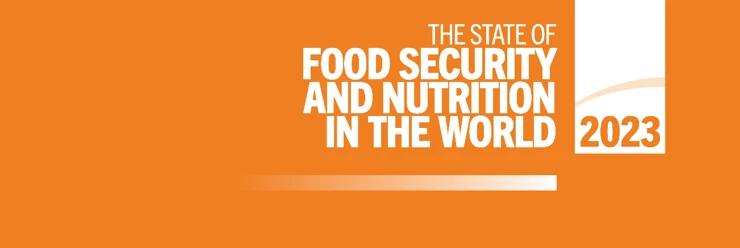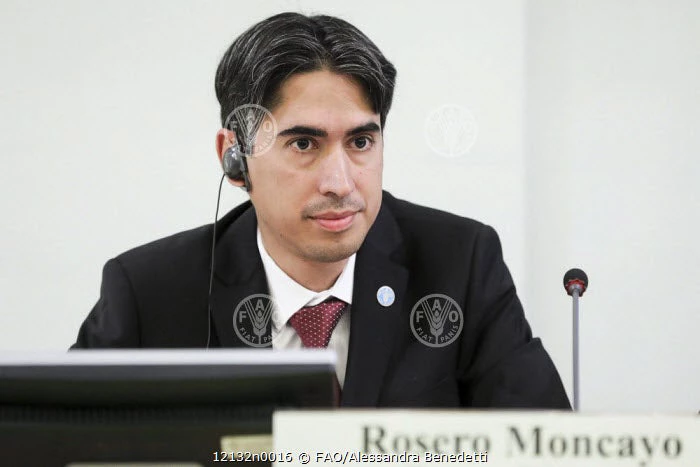On July 12, 2023, the State of Food Security and Nutrition in the World (SOFI) 2023 (published by the Food and Agriculture Organization (FAO) and jointly produced with fellow UN agencies) provided the latest estimates of the Cost and Affordability of a Healthy Diet (CoAHD) indicators. The data reveal that more than 3.1 billion – or 42 percent of the world’s population – could not afford a healthy diet in 2021. This is an increase of 134 million people compared to 2019, before the onset of the COVID-19 pandemic.
The CoAHD indicators - available through FAOSTAT and the World Bank’s DataBank (Food Prices for Nutrition Dataset Version 2.0) - show that:
- The global average cost of a healthy diet in 2021 was 4.3% higher than in 2020, and 6.7% higher than in 2019. This increase is due to rises in inflation in 2020 and 2021, mainly driven by the ongoing effects of the pandemic.
- Worldwide in 2021, the average cost of a healthy diet was $3.66 per person per day in purchasing power parity (PPP) terms. The cost was higher in Latin America and the Caribbean ($4.08) compared to Asia ($3.90), Africa ($3.57), Northern America and Europe ($3.22), and Oceania ($3.20).
- In Africa, Asia, and Latin America and the Caribbean, the cost of a healthy diet increased by more than 5% between 2020 and 2021, negatively affecting all subregions except for Northern Africa, where the cost fell by 2.8%. Over the same period, the cost of a healthy diet rose in Oceania (5.2%) and in Northern America and Europe (marginally, by 0.6%).
- More than 3.1 billion people (42% of the global population) were unable to afford a healthy diet in 2021. This figure is down somewhat from almost 3.2 billion people – or 43% – in 2020. The impact of escalating prices, coupled with a reduction in disposable income in many countries, resulted in an additional 186 million people unable to afford a healthy diet in 2020 compared with 2019. Lockdowns, economic downturns, and other pandemic-related disruptions in 2020 led to job losses and reduced incomes for many people, affecting the lowest-income households the most as they spend a higher share of income on food.
- A slight turnaround occurred in 2021, when the number of people unable to afford a healthy diet declined by 52 million compared to 2020, but this is still 134 million more people compared with pre-pandemic levels in 2019. A rebound in global GDP growth to 6 percent in 2021 likely alleviated the burden of unaffordability, owing to several factors, including government stimulus programs, social protection measures, and employment recovery, in some instances. However, an unequal pattern of economic recovery has made a healthy diet less affordable especially in some regions.
- While Asia had the largest number of people who were unable to afford a healthy diet (1.9 billion) in 2021, Africa reported the highest proportion of the population unable to afford the diet (78%) compared to Asia (44%), Latin America and the Caribbean (23%), Oceania (3%), and Northern America and Europe (1%).
- Southern Asia showed the highest number (1.4 billion) and proportion (72%) of the population unable to afford a healthy diet in Asia, with the prevalence almost twice the regional average. Eastern and Western Africa reported the highest proportion (85%) in the Africa region, as well as the highest number (712 million), when considered together.
Key messages by country income group:
- From 2020 to 2021, the cost of a healthy diet increased proportionately more in lower-middle-income countries (6%) compared to upper-middle-income and low-income countries (5%), as well as high-income countries (2%).
- In lower-middle-income countries, the surge in the cost of a healthy diet for two consecutive years led to 119 million more people unable to afford a healthy diet in 2021 compared to pre-pandemic levels in 2019. Additionally, 23 million more people in low-income countries found the diet unaffordable, while in upper-middle-income and high-income countries, the number of individuals unable to afford the diet decreased by 5 million and 3 million, respectively.
The State of Food Security and Nutrition in the World (SOFI) 2023 Report
The State of Food Security and Nutrition in the World (SOFI) is an annual flagship report jointly prepared by the FAO, the International Fund for Agricultural Development (IFAD), the United Nations Children's Fund (UNICEF), the World Food Programme (WFP), and the World Health Organization (WHO). It monitors the world’s progress towards ending hunger, achieving food security and improving nutrition, and provides analysis on key challenges for achieving these goals in the context of the 2030 Agenda for Sustainable Development. It serves as a vital tool for policymakers, researchers, and practitioners working in the field of food and nutrition.
The SOFI 2023 report, launched on July 12, 2023, focuses on “Urbanization, Agrifood Systems Transformation, and Healthy Diets Across the Rural-urban Continuum,” and explores the implications of urbanization for the availability and affordability of healthy diets, food security, and nutrition. Read more about the launch event here.
Food Prices for Nutrition
Food Prices for Nutrition, a collaboration between the World Bank, Tufts University, and the International Food Policy Research Institute (IFPRI), was established to provide national governments, international organizations, and development agencies with accurate metrics on the cost and affordability of diets and food groups. It relies on consumer retail prices and household expenditures to measure people's access to locally available foods necessary for a healthy diet. Since 2020, Food Prices for Nutrition has been collaborating with FAO and supporting the SOFI report on the estimation and publication of the Cost and Affordability of a Healthy Diet (CoAHD) indicators at the global level, relying on the data provided by the International Comparison Program (ICP) led by the World Bank, the Poverty and Inequality Platform (PIP) of the World Bank and data provided by FAOSTAT.
Food Prices for Nutrition eLearning course
The online training course “Cost and Affordability of a Healthy Diet and other Indicators” will be launched on the World Bank’s Open Learning Campus in July 2023. It aims to train users in the construction of CoAHD and other indicators. Keep an eye out for our forthcoming data blog introducing the course.
The authors are pleased to acknowledge the contribution of Edie Purdie in preparing data visualizations for this blog.








Join the Conversation